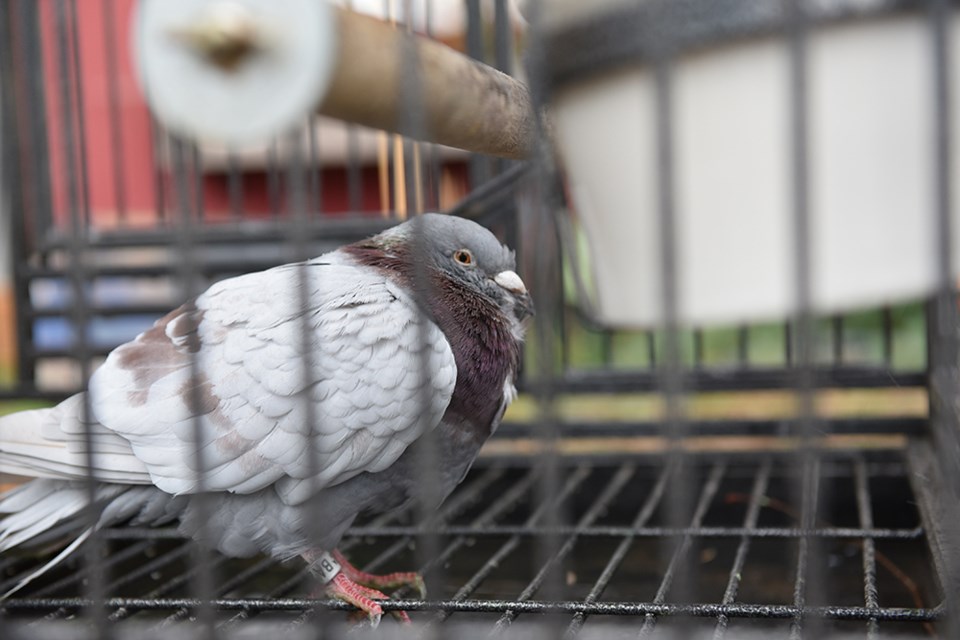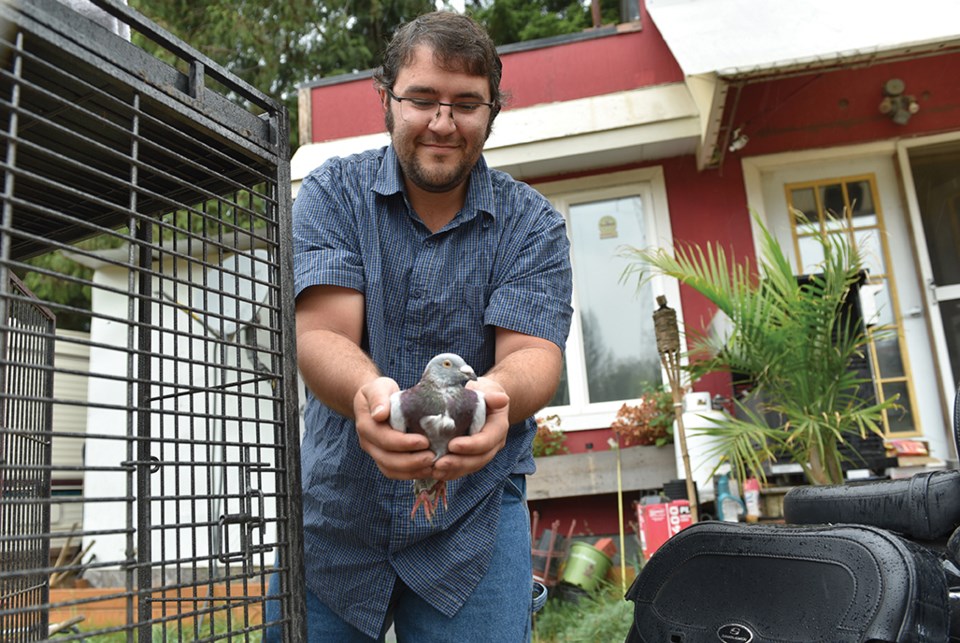This summer’s wildfire season left both humans and their pets struggling in thick smoke – but the late haze that wafted through Squamish in September might have rerouted some professional pigeons from the Lower Mainland.
On Sept. 4, Harry Midgley noticed a small pigeon roaming his Cheekye front yard. The light grey bird had a brown and purple band on its neck and a small dark grey head.
The bird immediately took a liking to both Midgley and his motorcycle – it was happy to perch on his knee, foot or in his hands. A band around the bird’s legs with numbers and letters led Midgley to the website for the CPFA – the Canadian Pigeon Fanciers Association, which he contacted to try and track the owner.
In the meantime, Midgley brought out an old birdcage to protect the bird from predators, provided some seed and water and consulted a local Squamish Facebook group for advice on what to do with Homie – the name he gave the bird.
South of Midgley near Brackendale, Squamish resident Jessica Adams, and her children were being charmed by their own feathered visitor. They’d noticed that like clockwork, a grey-and-white pigeon with red banded feet would visit their yard.
“It was really hungry and thirsty on the first day, but it perked up,” said Adams. “I figured maybe it needed to refuel and go back to wherever it came from.”
For five days in a row, the bird visited at the same time each day, before flying off to spend the night somewhere else.
Adams’ four-year-old son dubbed the curious bird “Jailbird” because of the cuffs on its legs, while her daughter borrowed a water bowl and some turf from their pet rabbits to make it more comfortable.
Like Midgley, Adams took to Facebook to try and find the owner of the bird. A little shier than Homie, she had to take zoomed-in photos to try and read the numbers on the band.
Some people might call pigeons “rats with wings” but Adams said the little bird was a hit.
“My kids love the bird,” she said, joking that she might now keep pigeons instead of chickens. “It just hangs around the water bowl and eats— pretty cool little bird. This one is very sweet.”

Midgley and Adams assumed that the thick smoke stranded the birds in their backyards – whether breathing it in had tired out the small creatures, or perhaps the visibility had interrupted their navigating ability.
The local who runs the local NANA (Neighbourhood Animals Needing Assistance) group for the Sea to Sky said reports of lost pigeons in Squamish are fairly rare, especially compared to missing cats and dogs.
The social media page – which helps reunite lost pets with owners – has been in operation since 2016, but there have only been two submissions for lost pigeons.
Head to the city and the common rock pigeon, or Columa livia, isn’t hard to find. They’ll hang out anywhere that they might find a snack.
The birds are a little rarer in Squamish, but a small flock is known to hang out on warm days near the Howe Sound Brewery. The larger band-tailed pigeon is also seen in Squamish but is a species of “special concern” according to the B.C. government.
Keeping pigeons as pets, although a very old tradition, is becoming rarer and rarer in the province.
According to Dave Naylor, who lives in Langley, there’s only one person in Brackendale who still keeps the birds. Plenty of breeders and racers operate in the Lower Mainland, in the Interior, and on Vancouver Island, but no one keeps racing birds anymore in Squamish or Whistler.
“The smoke would have slowed them down a bit, probably had an impact on breathing as they were flying,” said Naylor.
He said pigeons from the city sometimes fly as far as Medicine Hat, and occasionally they go north through Whistler and back to the city. Adams and Midgley didn’t have any success IDing their birds, but Naylor said if they were racing pigeons, they likely came from the Fraser Valley.
Naylor doesn’t race the birds himself anymore, but his Langley born-and-raised pigeons travel across North America to compete in sporting events like the California Classic, the Holiday Cup, and the Triple Crown.
They can fly up to 300 miles in long races and are tracked by an electronic chip on their leg. Prizes awarded to winning birds can reach US$90,000. Naylor said pigeon racing is more popular than horse racing in California.
In Vancouver, it’s getting harder for the pigeons to find their way home.
Naylor said the re-introduction of the peregrine falcon has made the sport more difficult, and there’s also speculation that cell towers interfere with the birds’ navigation. Tougher municipal bylaws in cities, including Vancouver, have also made keeping the birds more difficult.
“The sport is diminishing, but it’s still fairly active on the island and in the Interior, but there are fewer and fewer clubs in the valley,” said Naylor.
Still, fancy pigeons and racers get lost often enough that the Canadian Pigeon Fanciers Association website has detailed instructions for what to do with a lost bird.
“The bird can be temporarily kept in a cardboard box with light and air holes cut into all sides while you are awaiting its owner,” instructs the organization, adding that bread should be avoided but seed and clean water will help the bird recover if it appears tired.
So if you see a lost pigeon with banded feet, stay cool. Most friendly fliers are just taking a break and looking for friendly humans to help out with some food and water.





